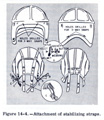TYPE H-3 PROTECTIVE HELMET
Description
The H-3 protective helmet consists of a cloth underhelmet (liner) and a rigid
protective shell. As shown in figure 14-1, the liner fits snugly, provides an attachment
for the oxygen mask, and includes a set of radio communication earphones.
Figure 14-2 shows an inside view of the protective shell. Figure 14-3 illustrates the
fully equipped H-3 protective helmet assembly.




Construction
The liner is available in five sizes; small, medium, intermediate, large, and extra large.
The size of the liner can be adjusted by means of a nylon strap and buckle that is sewn on
the back of the liner.
The oxygen mask is attached to the cheek flap by means of two Pull-the-Dot snap fasteners.
The matching female fasteners on the mask have a dot on their outer surface, and unlock in
one direction when pulled apart away from the dot. This provides positive locking action,
insuring the pilot of keeping the oxygen mask even if he loses the protective helmet
during a high-altitude bailout.
The earcups on the liner have been designed to accommodate wafer type receiver. The
wafer-thin construction of the receiver decreases the lateral dimensions of the helmet,
thereby decreasing the frontal area exposed to the windblast during bailout and
facilitating head movements within the confines of the cockpit canopy. The earcups have
been designed to provide sound attenuation against ambient noise, and to increase radio
reception.
One male snap fastener is locate on each side of the shell exterior between the two
buckles for adjusting the headband. This also provides a means of attaching the goggles to
the shell. In addition, a fitting is secured to the right side of the shell exterior for
attaching a boom type microphone. This microphone is very fragile and should be handled
with care.
The rigid protective shell is composed of laminated and mat Fiberglas compounded with
polyester resin. The rigidity oh the shell is increased by reinforcing-ridges located on
its outer surface. A black rubber beading around the borders of the shell protects the
wearer from sharp edges and provides a decorative finish.
The protective shell is available in four sizes; small, medium, large, and extra large.
Tests have shown that the Navy’s protective helmets will withstand an impact force in
excess of 64 foot-pounds and a static load in excess of 600 pounds without structural
failure.
WARNING: The wearer of the protective helmet should be instructed to not place any metal objects on the shell, especially above ear level. Under crash conditions, these additional metals may be driven into the head as secondary missiles.
Additional protection against injury from impact is provided by energy-absorbing
padding inside the helmet shell, consisting of four pieces of Royalite cemented directly
to the shell interior and small pieces of leather-covered foam rubber placed
circumferentially between the adjustable headband and the shell. Deformation of all parts
of the padding under impact absorbs the impact energy, thereby decreasing the injury
potential of a blow delivered to the helmet shell.
The shell is fitted to the head by means of a sling suspension having an adjustable
headband. Buckles for adjustment are located on both sides of the shell exterior just
above the ear level. The most protection against impact is obtained when the headband is
adjusted to fit snugly. Pilots and aircrewmen should be instructed in the proper procedure
to adjust the slings very carefully prior to use.
A modification to the H-3 consists of installing stabilizing straps and chinstrap to
provide the additional stability needed when catapulting, on arrested landings, and in
maneuvers involving high "g" accelerations. To attach the straps to the liner
and outer shell on any protective helmets that have not already been made by the
manufacturer, follow the procedure illustrated in figure
14-4.
The wearer need not separate the assembly after it is modified since it can be utilized as
a one-piece helmet. The modified cloth underhelmet (liner) should not be worn by itself
since attempts to anchor the webbing by additional fasteners on the liner may increase the
possibility of serious head injury in emergencies.